![]() Paul Trunfio's Home & Garden Pages | Paul Trunfio's Home Page
Paul Trunfio's Home & Garden Pages | Paul Trunfio's Home Page
My Dad and I have been following these instructions for years with wonderful success (my dad since roughly 1976 and myself since 1996). Keep in mind, that we live in a Zone 5/6 area (Boston), so issues such as starting indoors and storage might not be applicable to your individual case.
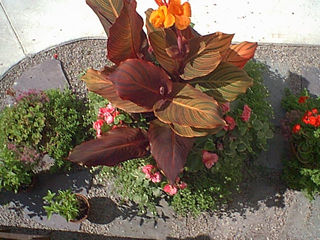 Uses: Beds, planters,
and backgrounds. For example, beds should contain at least 10 or more
Canna with borders of different flowers. Raised or mounded beds create
a more stunning effect. Planters can contain 1-2 Canna in a 3 foot
diameter pot or whiskey barrel with border flowers and vinca.
Backgrounds are more tricky. It is always best to limit the effect to
an area where you can put canna together as a focal point. For example,
a triangular corner of a yard along a fence (with, say 11 Canna: 2 in
back row, 4 in middle row, 5 in front row) would work. Planning is
crucial. A row of Canna as a property border or foundation planting
would not work visually and are examples of poor planning. Canna work
well as a single plant in pots, but they should be in large enough pots
to allow for other flowers to create color of various heights. Be
careful when using Canna as single specimens in a garden. This can
produce nice effects, but visually it doesn't work well for tall Canna.
Uses: Beds, planters,
and backgrounds. For example, beds should contain at least 10 or more
Canna with borders of different flowers. Raised or mounded beds create
a more stunning effect. Planters can contain 1-2 Canna in a 3 foot
diameter pot or whiskey barrel with border flowers and vinca.
Backgrounds are more tricky. It is always best to limit the effect to
an area where you can put canna together as a focal point. For example,
a triangular corner of a yard along a fence (with, say 11 Canna: 2 in
back row, 4 in middle row, 5 in front row) would work. Planning is
crucial. A row of Canna as a property border or foundation planting
would not work visually and are examples of poor planning. Canna work
well as a single plant in pots, but they should be in large enough pots
to allow for other flowers to create color of various heights. Be
careful when using Canna as single specimens in a garden. This can
produce nice effects, but visually it doesn't work well for tall Canna.
Habit: Striking broadleaved 1.5 to 4 foot plants (some varieties reach 6 or more feet), bear flower spikes of 4-5 inch gladiolus-like flowers of white, cream, yellow, pink, orange or red from July til frost. Foliage is in shades or green, bronze, or varigated.
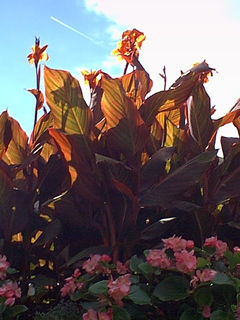 Germination: Sow
outdoors after all danger of frost is past where plants are to grow
(follow instructions under "Planting and Care"). For best results, sow
indoors during early April (zone 5/6), maintaining a temperature around
70F. If sowing indoors, place rhizomes with eyes up in a strong tray
filled with 2 to 2.5 in. sand. Cover each rhizome with sand and water
thoroughly. If possible, provide bottom heat (for example, roof heating
cables) to the sand filled trays to start and maintain rapid growth.
Water well at least twice per week and provide water soluble plant
fertilizer (for example, Miracle Gro) after plants start to grow and
every two weeks thereafter. Alternatively, use a 10-to-1 dilution and
fertilize daily.
Germination: Sow
outdoors after all danger of frost is past where plants are to grow
(follow instructions under "Planting and Care"). For best results, sow
indoors during early April (zone 5/6), maintaining a temperature around
70F. If sowing indoors, place rhizomes with eyes up in a strong tray
filled with 2 to 2.5 in. sand. Cover each rhizome with sand and water
thoroughly. If possible, provide bottom heat (for example, roof heating
cables) to the sand filled trays to start and maintain rapid growth.
Water well at least twice per week and provide water soluble plant
fertilizer (for example, Miracle Gro) after plants start to grow and
every two weeks thereafter. Alternatively, use a 10-to-1 dilution and
fertilize daily.
Planting and Care: If sowing indoors, bring trays outside after danger of frost (usually first week of May) to allow plants to adjust to the outdoors. Anytime after mid-May, plant in full sun in a rich soil with good drainage, 12-24 inches apart. Add plenty of organic ammendments such as manure and peat moss. If sowing outdoors, plant earlier (immediately after last frost). Provide granular fertilizer (such as 12-10-6) at bottom of planting hole, mixing well into the soil. Mulch with pine bark mulch to prevent erosion and retain moisture when watering. Though drought tolerant, Canna do thrive when well-watered. For best results, Canna should be soaked from a hose with soaker attachment or in-ground soaker hoses every day during the hot days of July and August (morning is best, early evening is second best). Cool or overcast periods will require less watering. Typically, watering can end by early September. Fertilize with granular fertilizer and/or with a hose-end sprayer with water soluble fertilizer. I use a water soluble fertilizer every 10 days to 2 weeks during the first half of the growing season. During mid- to late summer, I switch to a 5-10-5 type granular fertilizer at the base. One last chore: each plant will produce several shoots of flowers, one after the next. After a flower shoot has died, cut the shoot towards the stalk for appearance and to promote growth of new shoots.
Storing: After plants have been blackened by frost (typically middle October), cut the stalks to one inch above the ground, dig the clump and remove some of the soil around the edge and roots. Let the clumps dry in the sun for a couple of days upside-down. After drying, store each clump in a box surrounded by Perlite (recommended because it is less messy) or peat moss. Store in a cool basement with temperature around 40-50F. About once per month lightly moisten the Perlite so that the rhizomes do not dry. In March, take the clumps from each box, remove remaining soil, and break the twisted clumps into smaller clumps each containing at least three eyes. Each clump will yield four or more new rhizomes.
2010 Season Update: I am completing a major landscaping project at our house in Stow, MA. See Paul's Landscape Projects Notebook (2008-present). After a 7 year absence, Canna are returning to my gardens as a single mass planting bed!
2006 Season Update: Since we have moved, our landscaping tends
to include perenials. But my father keeps planting his Canna every
year. Here are some shots of his 2006 Canna beds.
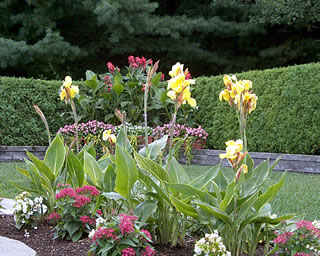
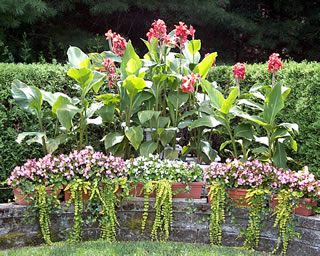
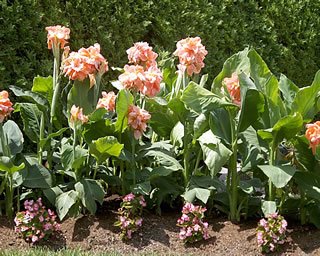
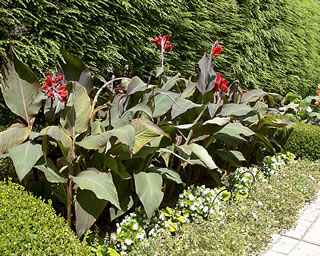
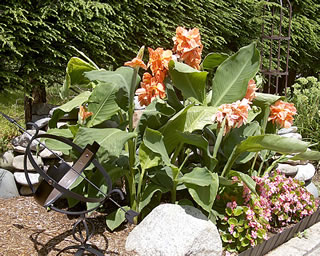
2002 Season Update: We moved this year, so we did not expand our Canna varieties. This year we stuck with our run-of-the-mill Yellow Canna for our single 10 foot diameter circular bed (surrounded by three rows of burgundy-leaf wax begonias) because of their early flowering tendencies (in time for our open houses)! We will see what next season brings.
2001 Season Update: Because of an unusually cold winter, we lost about 75 percent of our Canna's that we stored in a relative's basement. So, I bought a couple of new varieties, "Black Knight" and "Dwarf Primrose Yellow", and ventured into dwarf Canna's from seed (Tropical Rose). The results: (1) Black Knight was superb, not too tall (about 5 feet) with an abundance of deep red flowers and full velvety dark green leaves. I was afraid these were going to be sparse monsters, but they were not. Instead they grew to about 5 feet tall and were a real show stopper. (2) Primrose Yellow were a typical yellow-flowered Canna (with splotches of red in the middle of the flower) with green leaves. They were in a partly sunny location and grew to about 3 feet tall. I liked them precisely because of their small size and will be propagating these for next year. I used them in between shrubs in small clumps. Next year I will add more locations. (3) Dwarf Tropical Rose were disappointing. I hard a hard time starting these as they did not want to sprout through the hard seed shell. Only 6 out of 20 sprouted, and only 4 of these made it. They were never full and lush like the Park's pictures and two of them did not flower at all despite plenty of water/fertilizer and sunny location (became shady after 3pm). I will start them again this year (I saved seeds) and see what happens. This year, I will soak the seeds longer, slice the outer shell, start earlier, and place in a sunnier location. For 2002, we will be ordering even more varieties, probably Pretoria, Cleopatra, and Striped Beauty.
2000 Season Update: We have three main varieties of Canna that we propagate (I appologize for not knowing the true names): Ambrosia double flowers (I think this is "Miss Oklahoma") with green leaves, yellow flowers with green leaves, and "Tropicanna" with orange flowers and redish variegated leaves. Each grow anywhere from 4-6 feet depending on sun and care. We are thinking of adding varieties for next year.